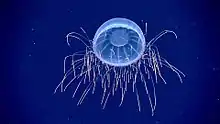| Halitrephes | |
|---|---|
 | |
| Scientific classification | |
| Domain: | Eukaryota |
| Kingdom: | Animalia |
| Phylum: | Cnidaria |
| Class: | Hydrozoa |
| Order: | Trachymedusae |
| Family: | Halicreatidae |
| Genus: | Halitrephes Bigelow, H. B. (1909) |
| Species: | H. maasi |
| Binomial name | |
| Halitrephes maasi Bigelow, H. B. (1909) | |
| Synonyms | |
| |
Halitrephes maasi, commonly known on the internet as the firework jellyfish, is a species of deep sea hydrozoan of the family Halicreatidae. The most recent account of the jelly has been found at a depth of 4,000–5,000 feet (1,200–1,500 m) near the Revillagigedo Archipelago off Baja California Peninsula, Mexico.[1]
Although not much is known regarding this species, research proves that Halitrephes maasi can be found in diverse settings of waters. The hydrozoan has been spotted in both temperate and tropical waters, and has been found in the Atlantic, Indo-Pacific, Antarctic, Mediterranean,[2] and eastern Pacific.[3] This hydromedusae is typically bathypelagic. In these waters, this species is most commonly found in oxygen minimal zones and deep waters.[4]
All cnidarians are diploblastic acoelomate metazoans, with tissue constructions levels.[5] The majority of the organisms in the phylum project lengthy hollow piercing tubular-filaments that are used to inject toxins and poison into their prey. Cnidarians are basic animals both physically and biologically. There is only one opening that functions as the mouth and the anus in its digestive system.[5]
References
- ↑ "WoRMS - World Register of Marine Species - Halitrephes maasi Bigelow, 1909". www.marinespecies.org. Retrieved 2018-01-25.
- ↑ Gili, J. M.; Bouillon, J.; Pages, F.; Palanques, A.; Puig, P.; Heussner, S. (1998-06-30). "Hidromedusas profundas del Mediterráneo: Un estudio que incluye la descripción de dos nuevas especies recolectadas en cañones submarinos del Mediterráneo Occidental". Scientia Marina. 62 (1–2). doi:10.3989/scimar.1998.62n1-2113. hdl:10261/23360. ISSN 1886-8134.
- ↑ Corrales-Ugalde, Marco; Quesada, Andrés J.; Naranjo-Elizondo, Beatriz; Cortés, Jorge (September 2018). "New records of gelatinous zooplankton from an oceanic island in the Eastern Tropical Pacific". Journal of the Marine Biological Association of the United Kingdom. 98 (6): 1219–1226. doi:10.1017/S0025315417000558. ISSN 0025-3154. S2CID 91093507.
- ↑ Hoving, P. N.; Hauss, H.; Christiansen, S.; Kiko, R.; Robison, B. H.; Silva, P.; Körtzinger, A. (2020). "In situ observations show vertical community structure of pelagic fauna in the eastern tropical North Atlantic off Cape Verde". Scientific Reports. 10 (1): 21798. Bibcode:2020NatSR..1021798H. doi:10.1038/s41598-020-78255-9. PMC 7733502. PMID 33311534.
- 1 2 Gasca, Rebeca; Loman-Ramos, Lucio (2014). "Biodiversidad de Medusozoa (Cubozoa, Scyphozoa e Hydrozoa) en México". Revista Mexicana de Biodiversidad. 85, Supp. 1: 154–163. doi:10.7550/rmb.32513.
External links